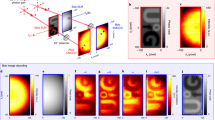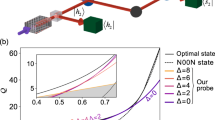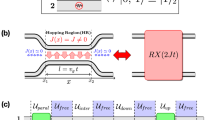Abstract
Quantum states and measurements exhibit wave-like (continuous) or particle-like (discrete) character. Hybrid discrete–continuous photonic systems are key to investigating fundamental quantum phenomena1,2,3, generating superpositions of macroscopic states4, and form essential resources for quantum-enhanced applications5 such as entanglement distillation6,7 and quantum computation8, as well as highly efficient optical telecommunications9,10. Realizing the full potential of these hybrid systems requires quantum-optical measurements sensitive to non-commuting observables such as field quadrature amplitude and photon number11,12,13. However, a thorough understanding of the practical performance of an optical detector interpolating between these two regions is absent. Here, we report the implementation of full quantum detector tomography, enabling the characterization of the simultaneous wave and photon-number sensitivities of quantum-optical detectors. This yields the largest parameterization to date in quantum tomography experiments, requiring the development of novel theoretical tools. Our results reveal the role of coherence in quantum measurements and demonstrate the tunability of hybrid quantum-optical detectors.
This is a preview of subscription content, access via your institution
Access options
Subscribe to this journal
Receive 12 print issues and online access
$209.00 per year
only $17.42 per issue
Buy this article
- Purchase on Springer Link
- Instant access to full article PDF
Prices may be subject to local taxes which are calculated during checkout



Similar content being viewed by others
References
Kuzmich, A., Walmsley, I. A. & Mandel, L. Violation of Bell's inequality by a generalized Einstein–Podolsky–Rosen state using homodyne detection. Phys. Rev. Lett. 85, 1349–1353 (2000).
Shchukin, E. & Vogel, W. Universal measurement of quantum correlations of radiation. Phys. Rev. Lett. 96, 200403 (2006).
Parigi, V., Zavatta, A., Kim, M. & Bellini, M. Probing quantum commutation rules by addition and subtraction of single photons to/from a light field. Science 317, 1890–1893 (2007).
Ourjoumtsev, A., Jeong, H., Tualle-Brouri, R. & Grangier, P. Generation of optical ‘Schrödinger cats’ from photon number states. Nature 448, 784–786 (2007).
Braunstein, S. L. & van Loock, P. Quantum information with continuous variables. Rev. Mod. Phys. 77, 513–577 (2005).
Ourjoumtsev, A., Dantan, A., Tualle-Brouri, R. & Grangier, P. Increasing entanglement between Gaussian states by coherent photon subtraction. Phys. Rev. Lett. 98, 030502 (2007).
Takahashi, H. et al. Entanglement distillation from Gaussian input states. Nature Photon. 4, 178–181 (2010).
Neergaard-Nielsen, J. S. et al. Optical continuous-variable qubit. Phys. Rev. Lett. 105, 053602 (2010).
Guha, S. Structured optical receivers to attain superadditive capacity and the Holevo limit. Phys. Rev. Lett. 106, 240502 (2011).
Tsujino, K. et al. Quantum receiver beyond the standard quantum limit of coherent optical communication. Phys. Rev. Lett. 106, 250503 (2011).
Puentes, G. et al. Bridging particle and wave sensitivity in a configurable detector of positive operator-valued measures. Phys. Rev. Lett. 102, 080404 (2009).
Bimbard, E., Jain, N., MacRae, A. & Lvovsky, A. I. Quantum-optical state engineering up to the two-photon level. Nature Photon. 4, 243–247 (2010).
Laiho, K., Cassemiro, K. N., Gross, D. & Silberhorn, C. Probing the negative Wigner function of a pulsed single photon point by point. Phys. Rev. Lett. 105, 253603 (2010).
Boyd, R. Radiometry and the Detection of Optical Radiation (Wiley, 1983).
Luis, A. & Sanchez-Soto, L. L. Complete characterization of arbitrary quantum measurement processes. Phys. Rev. Lett. 83, 3573–3576 (1999).
Fiurášek, J. Maximum-likelihood estimation of quantum measurement. Phys. Rev. A 64, 024102 (2001).
D'Ariano, G. M., Maccone, L. & Presti, P. L. Quantum calibration of measurement instrumentation. Phys. Rev. Lett. 93, 250407 (2004).
Lundeen, J. S. et al. Tomography of quantum detectors. Nature Phys. 5, 27–30 (2009).
D'Auria, V., Lee, N., Amri, T., Fabre, C. & Laurat, J. Quantum decoherence of single-photon counters. Phys. Rev. Lett. 107, 050504 (2011).
Feito, A. et al. Measuring measurement: theory and practice. New J. Phys. 11, 093038 (2009).
Coldenstrodt-Ronge, H. B. et al. A proposed testbed for detector tomography. J. Mod. Opt. 56, 432–441 (2009).
Brida, G. et al. Full quantum characterization of superconducting photon counters. Preprint at http://arXiv.org/abs/1103.2991 (2011).
Akhlaghi, M. K., Majedi, A. H. & Lundeen, J. S. Nonlinearity in single photon detection: modeling and quantum tomography. Opt. Express 19, 21305–21312 (2011).
Řeháěk, J., Hradil, Z. & Ježek, M. Iterative algorithm for reconstruction of entangled states. Phys. Rev. A 63, 040303 (2001).
Nunn, J., Smith, B. J., Puentes, G., Walmsley, I. A. & Lundeen, J. S. Optimal experiment design for quantum state tomography: fair, precise, and minimal tomography. Phys. Rev. A 81, 042109 (2010).
Haeffner, H. et al. Scalable multi-particle entanglement of trapped ions. Nature 438, 643–646 (2005).
Sanders, B. C. Quantum dynamics of the nonlinear rotator and the effects of continual spin measurement. Phys. Rev. A 40, 2417–2427 (1989).
Datta, A. et al. Quantum metrology with imperfect states and detectors. Phys. Rev. A 83, 063836 (2011).
Laiho, K., Avenhaus, M., Cassemiro, K. N. & Silberhorn, C. Direct probing of the Wigner function by time-multiplexed detection of photon statistics. New J. Phys. 11, 043012 (2009).
Gerrits, T. et al. Generation of optical coherent-state superpositions by number-resolved photon subtraction from the squeezed vacuum. Phys. Rev. A 82, 031802 (2010).
Namekata, N. et al. Non-Gaussian operation based on photon subtraction using a photon-number-resolving detector at a telecommunications wavelength. Nature Photon. 4, 655–660 (2010).
Achilles, D., Silberhorn, C., Sliwa, C., Banaszek, K. & Walmsley, I. A. Fiber-assisted photon-number resolving detector. Opt. Lett. 28, 2387–2389 (2003).
Achilles, D., Silberhorn, C. & Walmsley, I. A. Direct, loss-tolerant characterization of nonclassical photon statistics. Phys. Rev. Lett. 97, 043602 (2006).
Acknowledgements
The authors thank G. Donati, T. J. Bartley, J. Eisert, X. Yang and A. Feito for assistance and fruitful discussions. This work was funded in part by the Engineering and Physical Sciences Research Council of the UK (EPSRC, project EP/H03031X/1), the US European Office of Aerospace Research & Development (EOARD, project 093020), the European Commission (under Integrated Project Quantum Interfaces, Sensors, and Communication based on Entanglement (QESSENCE) and Specific Targeted Research Project (STREP) Hybrid Information Processing (HIP)) and the Alexander von Humboldt Foundation. I.A.W. acknowledges support from the Royal Society.
Author information
Authors and Affiliations
Contributions
L.Z., H.B.C.-R. and A.D. contributed equally to this work. L.Z., H.B.C.-R., X.-M.J. and I.A.W. conceived the project and contributed to the design of the experiment and to laboratory measurements and data analysis. L.Z., A.D. and M.B.P contributed modelling and data analysis. G.P., J.S.L. and B.J.S. contributed to the initial conception of the project. All authors contributed to writing the manuscript.
Corresponding author
Ethics declarations
Competing interests
The authors declare no competing financial interests.
Supplementary information
Supplementary information
Supplementary information (PDF 375 kb)
Supplementary information
Supplementary information (XLS 363 kb)
Supplementary information
Supplementary information (XLS 309 kb)
Supplementary information
Supplementary information (XLS 392 kb)
Supplementary information
Supplementary information (XLS 4183 kb)
Rights and permissions
About this article
Cite this article
Zhang, L., Coldenstrodt-Ronge, H., Datta, A. et al. Mapping coherence in measurement via full quantum tomography of a hybrid optical detector. Nature Photon 6, 364–368 (2012). https://doi.org/10.1038/nphoton.2012.107
Received:
Accepted:
Published:
Issue Date:
DOI: https://doi.org/10.1038/nphoton.2012.107
This article is cited by
-
Learning quantum systems
Nature Reviews Physics (2023)
-
Single-qubit reaped quantum state tomography
Scientific Reports (2022)
-
Projective measurement onto arbitrary superposition of weak coherent state bases
Scientific Reports (2018)
-
Photon number resolution enables quantum receiver for realistic coherent optical communications
Nature Photonics (2015)
-
Natural light harvesting systems: unraveling the quantum puzzles
Journal of Mathematical Chemistry (2015)



